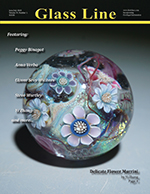 June/July 2025 - Vol. 39, No. 1.
June/July 2025 - Vol. 39, No. 1.

|
In This Issue
Delicate Flower Murrini by Yi Zhang
Some of my customers tell me they can feel the love energy in my work. I do find that science, art, and spiritual just come together as a whole. It made me understand that technical, artistic, and inspirational are all equally important in glass creation. They are all parts of human nature and never can be separated.
...

I first discovered the world of glass through my neighbor, Charlie Shoulders (@livingontheetch). I spent hours in his studio, watching him create the most marvelous things with glass rods and a torch. One day, I asked if there was any type of glass work he would like to do but couldn’t; his answer: “faceting!” Once he explained what that meant, I got started on a jig to use next to his 12” Crystal Master lap grinder. My first result was quick but hard to use. I kept refining the design, and 18 months later the LapDancer was born. In 2018, it was introduced to the world at the Michigan Glass Project.
My approach to build a faceting jig was unique enough that I was awarded a patent for the design in 2022 (image a).
That brings up the topic of the LapDancer vs. everything else. I created the LapDancer to solve a problem for a friend, and with no knowledge of other devices. The solution I arrived at was significantly less expenisve to build than other approaches, but was fairly similar in function to the existing machines. There is one exception, however...

I’m from Brittany in France. As far as I can remember, I’ve always been creative; I did all sort of crafts. When I was a little girl, my mum offered me a trade bead. I was fascinated by this glass bead and I tried to understand how it was made until 2017, when I had the opportunity to participate to a two-day lampwork initiation glass workshop and the mystery was revealed.
I didn’t practiced this art regularly until 2021 then. Since, I’ve taken some workshops to perfect myself and I’ve just started my small enterprise.
This tutorial uses the off-mandrel technique...

Art and creativity have always fascinated me. I graduated from the university with a degree in ceramic art. We drew a lot of graphics, painting, sculpting from clay, tried wood carving and fabric painting. I got to know glass in my freshman year at the institute. A friend gave me a master class for my birthday, and I really fell in love with glass.
I’ve been making glass art for 13 years now. I mostly use Effetre Moretti soft glass in my work, as well as Double Helix. I like to create sculptural beads in the form of animals: birds, bunnies, hedgehogs, owls, whales and fish, and more...

I began exploring small-scale glass sculptures in my jewelry designs. I liked to create pendants of female torsos, hands, feet, and faces. I wanted to take my two-dimensional background in painting the female form and people, and reflect it three-dimensionally in my glass work.
A few years ago, I moved from Colorado to Washington. During this time, I didn’t have a workshop for much longer than planned. I took up ceramics to continue the sculptural ideas that were rolling around my head and occupy my restless hands. The subject was still the female form. It was also at this time that I started researching glass kiln casting. I enjoy ceramics but, in my mind, I always looked at all of it as if it was glass, and that it would eventually be glass.
I finally built my new workshop and I’ve thrown myself back into glass full tilt. This time around, I am experimenting with a mixed media glass version of my work. I’m back at the torch but I’m also learning as much as I can about kiln casting with lost wax casting and paté de verre. My focus right now is sculptural. I am very much in the middle of an exploration/merger with my work. I think of my varied past work as puzzle pieces that may look unrelated but are beginning to fit into each other. All the little pieces of me (professionally and personally) and what that means in my work. Like I said, no path is ever straight. Don’t be afraid to embrace change and see where it takes you...
|
 April/May, 2025 - Vol. 38, No. 6.
April/May, 2025 - Vol. 38, No. 6.
|

